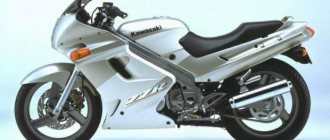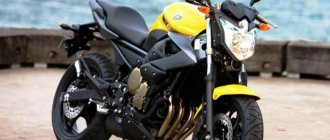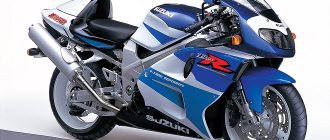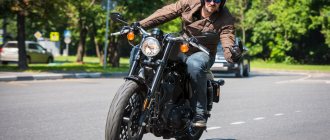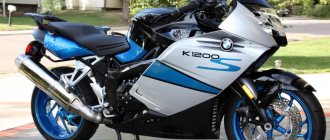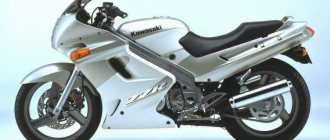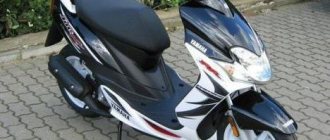The combination of the Honda XR600R chassis and the Honda NX650 Dominator engine led to the appearance of the Honda XR 650 enduro in 1992. For 18 years, the manufacturer did not make a single change to the model, which, however, in no way affected its popularity and competitiveness: against the background modern classmates XR 650 looks amazing, attracting attention with its advantages.
Review
The Honda XR 650 is perfectly described by one word that characterizes the motorcycle and explains its popularity - “reliability”. The engine design is primitive: an air cooling system and no overheating even in difficult operating conditions. Many motorists assume that the XR 650 power unit, given its venerable age, should be significantly inferior to modern analogues, but in practice the opposite is true: no one produces similar engines with an air cooling system and identical volume today. The only competitor to the Honda XR 650 that remains in service to this day is the Suzuki DR650 - an equally interesting motorcycle. Of course, the XR 650 engine also has its weaknesses related to the carburetor power system and environmental requirements. Owners of used models immediately after purchase, as a rule, remove the air system, replacing it with modern analogues that do not contradict the requirements of environmentalists.
Technical characteristics of Honda XR 650L
The motorcycle is equipped with an engine with a displacement of 644 cubic centimeters. The ignition system is represented by an electric starter, the power supply system is a carburetor. For 100 kilometers, the engine consumes 5.5 liters, the total volume of the fuel tank is 10.6 liters with a reserve of 2.3 liters, which ensures sufficient autonomy of the enduro and the ability to cover long distances. The transmission is five-speed, mechanical type, the hydraulic brake system with disc mechanisms is highly efficient and quick to respond. The rigidity of the motorcycle suspension is adjustable. The rear suspension is equipped with a monoshock absorber with a full travel of 279 millimeters.
The wheelbase of the Honda XR 650 is 1455 millimeters, the curb weight is 157 kilograms. A reliable chassis allows you to operate the motorcycle in difficult conditions.
Honda Cb 400 Manual
Steering wheel (CB400N). 1 — rear view mirror, 2 — brake light switch connector (front brake), 3 — master brake cylinder (front brake), 4 — fastening screw, 5 — accelerator handle bracket, 6 — accelerator cable end, 7 — accelerator handle, 8 — clutch cable tip, 9 — fastening bolt, 10 — clutch lever bracket, 11 — clutch lever, 12 — fastening screw, 13 — starter cable tip, 14 — steering switch housing, 15 — left steering wheel handle, 16 — starting device drive lever, 17 — plugs, 18 — steering wheel mounting bolt, 19 — steering wheel mounting bracket, 20 — steering wheel.
Steering column (CB400N). 1 — steering column mounting nut, 2 — washer, 3 — upper cross-member, 4 — headlight housing, 5 — bolt, 6 — brake hose bracket, 7 — lock nut, 8 — lock washer, 9 — upper cover, 10 — upper boot , 11 - cage No. 1, 12 - upper bearing, 13 - steering column, 14 - lower bearing, 15 - cage No. 4, 16 - lower boot, 17 - clip No. 2, 18 - clip No. 3.
Front wheel (removal and installation) (CB400N). 1 — front brake caliper mounting bolts, 2 — right brake caliper, 3 — left brake caliper, 4 — screw, 5 — speedometer cable, 6 — front axle mounting bolts (clamp connection), 7 — axle bolt, 8 — front axle mounting bolts axle (clamp connection), 9 - front axle, 10 - front wheel, 11 - bushing, 12 - speedometer drive.
Front wheel (disassembly and assembly) (CB400N). 1 — left oil seal (45x55x5), 2 — speedometer drive holder, 3 — right oil seal (28x42x8), 4 — brake disc mounting bolt, 5 • brake disc, 6 — left wheel bearing (6004UU), 7 — bushing, 8 — right wheel bearing (6004UU).
Front fork (disassembly and assembly) (CB400N). 1 — fender mounting bolt, 2 — front fender, 3 — boot, 4 — bushing, 5 — brake caliper bracket bolt, 6 — right brake caliper, 7 — left brake caliper, 8 — upper crossmember terminal connection bolt, 9 — terminal bolt connections of the lower yoke, 10 - fork leg assembly.
Fork leg (disassembly and assembly) (CB400N). 1 - plug, 2 - o-ring, 3 - bushing, 4 - spring seat, 5 - spring, 6 - boot, 7 - retaining ring, 8 - bolt, 9 - washer, 10 - shock absorber rod, 11 - rod o-ring, 12 — rebound spring, 13 — pipe, 14 — oil seal, 15 — retaining ring, 16 — bushing, 17 — bushing, 18 — oil seal, 19 — tip.
Steering column (CB400FIII). 1 — sound signal mounting bolt, 2 — sound signal, 3 — turn signal mounting bolt, 4 — turn signal indicator, 5 — headlight bracket mounting bolt, 6 — headlight bracket, 7 — steering column mounting nut, 8 — washer, 9 — upper traverse, 10 — headlight support, 11 — bolt, 12 — brake hose bracket, 13 — lock nut, 14 — lock washer, 15 — top cover, 16 — boot, 17 — clip No. 1, 18 — upper bearing, 19 — steering column, 20 — lower bearing, 21 — cage No. 4, 22 — boot, 23 — cage No. 2, 24 — cage No. 3.
Suspension Adjuster (CB400FII/IIIV)
To change the stiffness of the rear suspension, use the spring preload regulator, which has five positions (1 is the largest stroke, 5 is the smallest). The standard position is No. 4.
Right handlebar (GB400F). 1 — brake light switch connector, 2 — master brake cylinder (front brake), 3 — fastening screws, 4 — accelerator handle housing, 5 — accelerator cable nut. 6 — accelerator cable, 7 — handle tip, 8 — bracket cable, 9 — accelerator handle, 10 — retaining ring, 11 — terminal mounting bolt, 12 — right steering handle.
Left handlebar (CB400F). 1 — clutch switch connector, 2 — clutch lever, 3 — fastening screw, 4 — switch housing, 5 • starting cable, 6 — handle tip, 7 — handle (finish), 8 — retaining ring, 9 — terminal mounting bolt, 10 — left steering handle.
Front wheel (removal and installation) (CB400F). 1 — front wheel axle bolt, 2 — terminal mounting bolts, 3 — front wheel axle, 4 — front wheel, 5 — left support sleeve, 6 — right support sleeve.
Front wheel (disassembly and assembly) (CB400F). 1 — right support sleeve, 2 — left support sleeve, 3 — disc mounting bolts, 4 — brake disc, 5 • boot, 6 — left wheel bearing (6004UU), 7 — spacer sleeve, 8 — right wheel bearing (6004UU).
Front fork (CB400F). 1 — front fender mounting bolt, 2 — front fender, 3 — brake hose holder, 4 — caliper bracket bolts, 5 — brake caliper, 6 — instrument cluster mounting bolts, 7 — lower crossmember mounting bolt, 8 — upper crossmember mounting bolt, 9 - fork.
Engine
A unique characteristic of the Honda XR 650 is its power unit, equipped with a four-valve radial combustion chamber. The design feature is confirmed by the abbreviation RFVC - Radial Four-Valve Combustion - placed on the engine. The four-valve architecture of the power unit provides it with excellent low speeds and maintains traction at mid-range speeds. Among the engine features, many owners of the Honda RX 650L note a dry sump lubrication system and a hydraulic camshaft chain tensioner. The dry sump system completely eliminates oil starvation of the engine and its overheating; the hydraulic tensioner relieves the motorist from the need to adjust the chain tension.
Compared to modern power units, the Honda XR 650 engine has a low compression ratio of 8.3:1, thanks to which the motorcycle can run perfectly on any type of gasoline, including AI-80.
The XR 650 motorcycle is ideal for long trips, which is only facilitated by the large fuel tank and low fuel consumption.
The manufacturer tried to install the NX650 Dominator engine on several other motorcycle models, but, unfortunately, all projects were unsuccessful. In Munich in 2005, the Honda FMX 650 motorcycle concept was demonstrated, featuring an overly aggressive design and a derated 650 cubic centimeter engine. The power unit, which previously did not have decent power, was trimmed to 37 horsepower in the FMX 650 version. Interest in the model was fueled for several years, after which it sank into oblivion.
In 1997, the Honda SLR 650 debuted with a similar power unit. The road bike combined enduro performance with a 39-horsepower engine. In technical terms, it was a heavily deformed Dominator, which was very critically received by specialists and motorcyclists. Sales of the model began to plummet, which forced the company to release the road-conquering Honda FX 650 Vigor motorcycle in 1999, which, unfortunately, suffered the same fate as its predecessor: interest in it lasted only two years, after which the bike was discontinued in 2001 and is virtually forgotten by fans of the Japanese motorcycle company.
You can watch the slideshow here
Honda Vigor 650 - Zweiter Versuch
Aus KRADBLATT 11/99
von Klaus Herder
Es steht im Duden. Und zwar im Fremdwörterbuch, fünfte Auflage 1990, Page 813, ganz unten rechts. Vigor (lateinisch), der: Lebenskraft, Rüstigkeit, Stärke. Das alles klingt etwas nach munterem Rentner und der Kraft der zwei Herzen. Doch die Presse-Info zur Honda Vigor 650 (DIE Vigor, denn Frauen, Schiffe und Motorräder sind weiblich) weiß es besser: Von einem „brandneuen Streetbike” ist die Rede. Brandneu? Nun ja, den luftgekühlten Einzylinder-Motor kennen wir bereits seit über zehn Jahren. So lange treibt der kurzhubige Vierventiler bereits die Honda Dominator an. Tja, dann ist eben der Rest brandneu. Oder auch nicht. Rahmen, Räder, Bremsen - das alles wurde in gleicher Combination bereits 1997 und 1998 angeboten. Es hieß nur etwas anders: SLR 650. Die SLR vermarktete Honda damals als „City-Bike”, doch das ging gründlich daneben. Der Versuch, dem dynamischen Yuppie ausgerechnet eine hochbeinige und einigermaßen biedere 650er für den Kurzstreckenverkehr zu verkaufen grenzte an das Bemühen, den Eskimos Kühlschränke zu verkaufen. Nun folgt also der zweite Versuch. So ganz vom City-Image möchten sich die Honda-Werbestrategen dann aber doch nicht trennen. Zum Designkonzept verrät uns die Presse-Info im schönsten Marketingdeutsch folgendes: „Robuste Streetracerqualitäten signalisieren dabei die unter dem Sitz hervorragenden Schalldämpfer aus hochglanzpoliertem Edelstahl, wäh-rend der große Scheinwerfer, das kleine, sportliche vordere Schutzblech und ein elegantes High-Tech-Cockpit ihren urbanen Charakter unterstreichen.” Oha, ein High-Tech-Cockpit unterstreicht den urbanen Charakter - wer hätte das gedacht. Was da so unheimlich hightechig sein soll, ist vermutlich der Drehzahlmesser. Den gab es an der SLR nämlich nicht, die Vigor hat ihn serienmäßig. Und die Japaner setzten noch eins drauf und montierten eine „Halbverkleidung für Wind- und Wetterschutz im intensiven Stadtbetrieb” (O-Ton Honda). Abgesehen davon, dass wir uns unter einer Halbverkleidung bislang etwas anderes vorgestellt haben, dürfte das oberhalb des Scheinwerfers montierte Mini-Plastikschild beim Ampelstopp im strömenden Regen oder beim Durcheilen großstädtischer Pfützen nur wenig Schutz bieten . Aber das Teil ist neu und somit eine Erwähnung wert. Der Fahrersitz ist so geschickt geformt, dass kurze Menschen (mit kurz sind Werte um einssiebzig gemeint) die Füße sicher auf den Boden bekommen und lange Fahrer (lang ist alles über einsneunzig) trotzdem bequem sitzen. Zu schwer sollte der Vigor-Fahrer aber nicht sein, denn das vordere Polster verträgt Belastungen über 85 kg nur relativ kurzfristig, als Sitzgelegenheit dient dann ungewollt der Sitzbank-Rahmen. Zu zweit wird es zudem auch etwas eng. Der Sozius freut sich zwar über die zwei stabilen Haltegriffe, rutscht mit dem Allerwertesten aber zu weit in Richtung Gepäckträger. Der ist übrigens serienmäßig, aus Kunststoff und abnehmbar. Um die 39 Pferdestärken der Vigor zum Galoppieren zu bringen, bedarf es keiner großen Anstrengungen. E-Starter, lenkerfester Chokehebel, problemloses Startverhalten, sehr kurze Warmlaufphase - der Single benimmt sich völlig pflegeleicht. Kuppeln und Rühren im kurz übersetzten Fünfganggetriebe klappen ebenfalls ohne große Anstrengung. Was im Fahrbetrieb bereits auf den ersten Metern angenehm auffällt, ist die extreme Handlichkeit der Vigor. Mit 13 Litern Normalbenzin vollgetankt wiegt die Fuhre gerade mal 180 Kilogramm. Der Lenker ist fürs freche Kurvenschwingen breit genug und goldrichtig montiert, die Fußrasten sind fürs lässige Herumlümmeln ausreichend weit entfernt, und die Aussicht ist dank 85 Zentimetern Sitzhöhe ganz hervorragend. Zur Vigor fassen auch Anfänger sofort Vertrauen, sie hat nichts Bedrohliches. Klassisch mit Knieschluß ums Eck pfeifen klappt mit der knuffigen Honda genauso wie enduromäßiges In-die-Kurve-Drücken. Übermäßig viel Kraftaufwand ist dafür nicht erforderlich, die 650er schwenkt fast von allein um Biegungen aller Art und fällt förmlich in die Kurven. Kupplungshand und Schaltfuß haben dabei zumindest auf kurvigen Landstraßen immer kräftig zu tun. Unter 2500 U/min ruckt der Eintopf nur unwillig an der Kette, über 6000 U/min geht's nur noch zäh voran. Die Höchstleistung von 39 PS liegt bei 5750 U/min an, das maximale Drehmoment von 54 Nm stemmt der Vierventiler bei 4500 U/min — das nutzbare Drehzahlband fällt damit recht übersichtlich aus. Vor allzu fiesen Einzylinder-Vibrationen braucht der Besatzung dabei nicht bange zu sein. Eine Ausgleichswelle sorgt dafür, dass die gemeinsten Spitzen nicht durchkommen. Übers Arbeits- und Konstruktionsprinzip herrscht dennoch nie Unklarheit. Lange Autobahnetappen mit gleichbleibender Geschwindigkeit werden mit eingeschlafenen Händen nicht unter einer Stunde bestraft. Zu schlimm kann's aber nicht werden, denn nach rund 200 flotten Kilometern geht's dem Tank an die Reserve und spätestens drei Liter weiter sollte eine Tankstelle in Sicht kommen. Macht unterm Strich vier bis fünf Liter Verbrauch — eher vier, wenn man es bei gesetzeskonformer Landstraßengangart bellässt und nicht permanent die rund 160 km/h Vmax ausreizt. Für die in „Sparkling Red” (Signalrot) oder „Prime Metallic Blue” (Dunkelblau) lieferbare Vigor verlangt Honda 8990 Mark inklusive Nebenkosten. Das ist der gleiche Tarif, der auch schon für die etwas weniger gut ausgestattete SLR aufgerufen wurde. Damit ist die Vigor fast 1400 Mark günstiger als die motormäßig eng verwandte Dominator aus gleichem Haus und fast 3700 Mark billiger als die durchaus vergleichbare BMW F 650. Die Vigor ist also ein echtes Sonderangebot. Dass aber auch Honda nicht zaubern kann, merkt man beim Blick unters Kunststoffkleid: „Mono-Back- bone-Rahmen” hört sich zwar toll an, ist aber nichts anderes als eine Einfachst-Konstruktion aus zusammengeschweißten Stahlprofilen, die gleichzeitig als Rahmen und als Öltank der Trockensumpfschmierung dient. Das Teil ist stabil, eine Augenweide ist es nicht. Das Showa-Zentralfederbein, die konventionelle Telegabel und die von Brembo stammende Bremsanlage sind alles Zulieferteile, die unter normalen Bedingungen ganz ordentlicht funktionieren, über das Qualitätsurteil „durchschnittlich” aber nie hinauskommen. Besonders das im Soziusbetrieb hoffnungslos überforderte Federbein wird von ambition Vigor-Treibern spätestens nach der ersten Saison durch ein qualitativ hochwertigeres Teil ersetzt. Zusammengesteckt wird die Vigor übrigens in Spanien. Trotzdem: Unterm Strich ist die Honda Vigor 650 ein sehr faires Angebot und für Menschen interessant, die einfach nur Motorrad fahren möchten und aus ihrem Zweiradhobby nicht unbedingt eine Philosophie machen müssen. Fürs problemlose Austoben am Sonntagmorgen auf der Landstraße, für den Kurztrip zur Oma oder als Zweitmopped für alle Tage taugt die Vigor allemal. Für Anfänger ist sie eine gute Alternative zum Gebrauchtbike, und Wiedereinsteiger werden mit ihr ab der ersten Minute unkomplizierten Fahrspaß haben. Wenn Honda das unsägliche City-Bike-Geschwafel sein lässt, wird sich der neue alte Eintopf vielleicht sogar ganz gut verkaufen. Das Teil kann jedenfalls viel mehr, als nur in der Stadt herumzuhängen.
Honda FX 650 Vigor 1998
Make Model Honda FX 650 Vigor Year 1998 Engine Air cooled, four stroke, single cylinder, SOHC, Capacity 644 Bore x Stroke 100 X 82 mm Compression Ratio 8.3:1 Induction Single 40mm Keihin VE-type carb. Ignition / Starting Capacitor Discharge/electric Max Power 39.4 hp 28.7 kW @ 5750 rpm Max Torque 54 Nm @ 4500 rpm Transmission/Drive 5 Speed/chain Front Brakes Single 296mm disc 2 piston caliper Rear Brakes Single 220mm disc 1 piston caliper Front Tire 100/90-19 Rear Tire 120/90-17 Dry-Weight 161 kg Fuel Capacity 13 Litres Overview Motormag
Reviews
Despite its excellent technical characteristics, the Honda XR 650 has its drawbacks. For example, for short motorcyclists, the seating position is very uncomfortable due to the 940 mm seat height, but it also provides an impressive ground clearance of 330 mm. Some owners complain that the gears are too short, which is easily fixed by replacing the sprockets. The design of the rear subframe is too weak and unreliable, easily breaking under even light weight. Many owners of the Honda XR 650 in reviews advise strengthening the subframe with braces using a welding machine.
The motorcycle can hardly be called a two-seater, but riding it with a passenger is quite possible. The maximum speed of the XR 650 is 170 km/h; on the highway the bike easily maintains 120-130 km/h. Despite its dynamism, enduro is poorly suited for calm and measured, albeit high-speed, driving on an asphalt road - it feels much better on a gravel road or off-road. For serious off-road use, the model is too heavy; for high-speed asphalt roads it lacks power.
Review of the Honda FX650 Vigor motorcycle
1. Appearance: Vigor is definitely not a pretentious bike, it is unlikely to make girls shout “WOW!” and prostrate before him. The motorcycle is well made, high quality and functional. Nothing superfluous, just what you might need on the road: not a lot of plastic, it’s soft and of high quality. When impacted and loaded, it does not burst, but bends or scratches.
2. Comfort. In more than 2 weeks I rode the bike for about 1000 km, the last 500 km of which was on a short journey. The seat is very comfortable, the footrests are located in such a way that several seating options are possible, which makes life much easier for ****on the road - he doesn’t fuss or sit back. On Russian roads, the suspension feels excellent: on the one hand, smoothing out most of the potholes and potholes, and on the other, maintaining informative feedback from the road. At first, the vibration and rather short gear travel are a little confusing, but you quickly get used to it. The front plastic (windshield) is, in my opinion, a little low and does not protect well from the wind at speeds above 120-130 km/h. I installed a high glass, and now we can run at 160 (now it starts to blow away after 130-140).
3. Security. As sad as it may be, I already checked this parameter when I got into an accident and was hit by a jeep. The accident occurred at a speed of about 80-100. Result: the motorcycle behaved perfectly, its design allowed me not only to quickly “jump” without locking my legs, etc., but also to keep most of the bike intact. Among the strengths: the engine is recessed into the “body” of the motorcycle - it remained intact during the accident, the exhaust protection was dented, but protected the pipe from impact, the motorcycle's body is protected as usual by a small bumper - the instrumentation remained intact, the unprotected optics and plastic were damaged. Weak side: the steering wheel turned out to be weak at a bend - it should be written off. (installed Endurovsky - it only got better)
4. Reliability. Motor from Dominator, no further comments. Reliable.
5. Driving performance. Mixed feelings, especially after the high-revving Suzuki GSX. It doesn’t rush off the line, you give it gas and you want more, more... although when you lower your eyes to the speedometer, you realize that you’re at 100, 120, 140, etc. you squeeze it out. In fact, the motorcycle is calm and does not differ in its sporty character. Its strengths are not in this, but in very stable movement on the road, be it a highway, concrete, a dead road between villages and undergrowth paths and hills with grass. The “standard” tires cause displeasure; in my opinion, they should be replaced with fanged ones, especially if you plan to turn off the road into the forest.
General conclusions: The Honda FX650 Vigor is a good motorcycle for Russian roads, suitable for calm people who want to travel on any roads, and not just highways (which do not exist in Russia). There are no problems with service or spare parts.
The motor is beautiful, reliable and comfortable. I rode it to the Crimea, some positives, I got into an accident, the bike was almost intact, although it fell at 80 km/h. The only negative in my opinion is frequent oil changes - once every 3000 km, this is a feature of the engine.
So: Vigor is a logical continuation of the Dominator, adapted for urban traffic, but. Made by impulsive Italians (they were able to ruin even the “legendary engine”) and there are even more gimmor spare parts for it than for the ancient Japanese ancestors NX and SLR. There is no point in buying this device (well, only if you like it and everything here). The same broadcast of the shaggy year will last longer and is much more pleasant in service and use. IMHO
Design
The Honda XR 650 is not distinguished by the presence of a decorative body kit or an elegant exterior: the appearance of the motorcycle is classic for all enduros, which, however, does not detract from its attractiveness. The original optics leave much to be desired, which is why many motorcyclists resort to replacing them immediately after purchasing a motorcycle. The disadvantage is insignificant, it can be easily and quickly eliminated if you have the necessary budget and certain skills.
Transmission
Compared to its classmates, the Honda XR 650 is equipped with a reliable transmission with smooth and precise gear changes. Many motorcyclists consider its only drawback to be the difficulty in finding the neutral position of the lever, which requires certain skills from the pilot. The disadvantage is eliminated by regularly changing the transmission oil, and it is advisable to use high-quality original lubricant.
The high seat causes some inconvenience when riding at minimum speed, but significantly increases the motorcycle's handling on sandy roads, provided that the appropriate tires are available. High ground clearance eliminates the possibility of the motorcycle landing on its belly in mud or sand.
In terms of quibbles and malfunctions, the transmission has no complaints: it does not suffer from congenital diseases, during maintenance it only requires replacement of the pendulum cover, the service life of which is 5 thousand kilometers.
Why change the oil in your motorcycle fork to a more viscous one?
The oil in the motorcycle fork is changed to a more viscous one to increase the rigidity of the fork. The more viscous the oil in the fork, the harder it handles bumps. That is, a rigid fork is not the most comfortable option for bad roads. But, on the other hand, when driving on bad roads, the fork does not break so often. And the handling improves noticeably, the motorcycle does not bite so much during hard braking, the motorcycle becomes more responsive. In this case, you should take into account the value of oil hardness that the manufacturer recommends in the manual, but, again, there is one “but” here. If the motorcycle is new, of course, you need to pour the oil that the manual recommends (for the Honda cb 400 motorcycle this is oil with a viscosity of 10W). What if it’s not new, and the feathers are already pretty worn out? In short, my advice is to go with your gut feelings. The motorcycle started to nod - that’s it, it’s a symptom, it’s time to think about pouring more viscous oil into the fork.
And for reference. It is recommended to change the oil in the fork of a Honda cb 400 motorcycle every 15,000 kilometers. Oils of different hardness can be mixed, achieving intermediate values. That is, if you really really want 16.5W, you can mix 15W and 20W in appropriate proportions. At the same time, it is natural that the oil should be from the same manufacturer, since chemistry is chemistry, and manufacturing technologies from different manufacturers may differ slightly, and the result in this case is very difficult to predict.
In principle, in my experience, these 15,000 kilometers may not be maintained by combining the oil change in the fork with the replacement of the front shock absorber seals. On the Sibishka, oil seals are still a consumable item, and on our roads they begin to snot quite quickly.
Suspension
The characteristics and features of the suspension are fully justified taking into account the class of the Honda XR 650: the rigidity is sufficient to overcome uneven roads at high speed and ensure ideal handling of the motorcycle. The range of rebound and precompression settings for both front and rear suspensions is quite wide. It is almost impossible to “break through” the original suspension: in terms of its reliability, it is practically not inferior to the XR 650 engine.
Despite all its advantages, the suspension is still not suitable for hard use: the front fork springs are quite soft, the wheel bearings are too weak and quickly fail. When operating a motorcycle in mud and sand, the hinges of the suspension linkage mechanisms are subject to accelerated wear, and therefore it is advisable to have them diagnosed when purchasing a motorcycle.
Consequences of riding with a current fork
If you do not fix the problem of the Honda CB 400 fork leakage in time, you can end up with a motorcycle that is uncontrollable and jumps from any crack in the asphalt instead of a normal suspension. Moreover, fork oil usually leaks onto the brake calipers and floods the brake pads. And, as a result, a significant decrease in the efficiency of the braking system, which is vital for a motorcycle.
Repair of damaged fork stays and cups for Honda CB 400
In an accident, the impact often occurs on the front of the motorcycle. As a result of this, the feathers and cups of the Honda CB 400 fork are often bent, and there are also frequent cases of damage to the motorcycle yoke. In this case, there is often no need to purchase and install new expensive spare parts. Our motorcycle service repairs and restores forks and yokes for the Honda CB 400:
- Correcting motorcycle fork legs
- Editing motorcycle fork cups
- Editing a motorcycle traverse
Very often, when operating a motorcycle, mechanical damage to the fork leg mirror can occur. This also leads to fork leakage. In this case, replacing oil seals and anthers does not help. In this case, surface repair and polishing of the fork blade is necessary.
Replacing and servicing suspension bearings on a Honda CB 400
Wheel and steering column bearings play an important role in the suspension of a motorcycle.
The moment to replace wheel bearings comes when the motorcycle begins to scour the road, even at low speed. If these symptoms occur, it is necessary to replace the bearings in the motorcycle wheel.
The steering column bearing also wears out. Because of this, when taxiing, the motorcycle begins to behave unstably in turns, the steering wheel itself becomes in a certain position (usually in the middle). Elimination of this malfunction is possible only by replacing the motorcycle steering bearing.
If, when driving over uneven roads or when braking, you feel a knocking sound in the area of the steering column, then this is the first sign that your motorcycle’s steering bearings need to be serviced. If this is not done in a timely manner, it may lead to more expensive repairs and the replacement of expensive steering bearings.
Rear shock absorber repair or replacement
If, when riding a loaded motorcycle, the rear shock absorber breaks or the motorcycle wobbles when driving over bumps, then it is probably time to replace the rear monoshock absorber or 2 rear shock absorbers, depending on the model of your motorcycle.
If the model of shock absorber installed on your motorcycle is dismountable, then our motorcycle service repairs the rear shock absorber of the motorcycle.
Brake system
The bike's brakes easily cope with the engine's potential. The sensitivity of the system can be increased by installing disks of larger diameter, which is often resorted to by motorcyclists. In general, the braking system does not cause any complaints: it is highly effective and reliable, it provides fast and perfect deceleration at any speed.
Modifications
Over the entire existence of the model, several modifications of the motorcycle were produced, differing from each other by minor changes in the technical component and body color. A road version of the XR 650 was produced especially for the Japanese domestic market, equipped with universal tires, direction indicators and an electric starter. Similar models were released in limited editions and were quickly sold out by motorcyclists.
There are two main modifications of the motorcycle:
- The road version of the XR 650 L launched in 1992. It has a steel frame, an air-cooled engine, Showa suspension, an electric starter and an 11-liter fuel tank. The curb weight of the model is 157 kilograms.
- Produced from 2000 to 2007, the sports version of the Honda XR 650 R was equipped with an aluminum frame, an engine with a liquid cooling system (appeared in 2005), a ten-liter fuel tank, Kayaba suspension and a kick starter. Curb weight varied from 142 to 144 kilograms.
From 2012 to the present day, only the Honda XR 650 L modification has been produced and officially sold specifically for the US markets. Models with mileage in Russia can be purchased on the secondary market for at least 170 thousand rubles.


